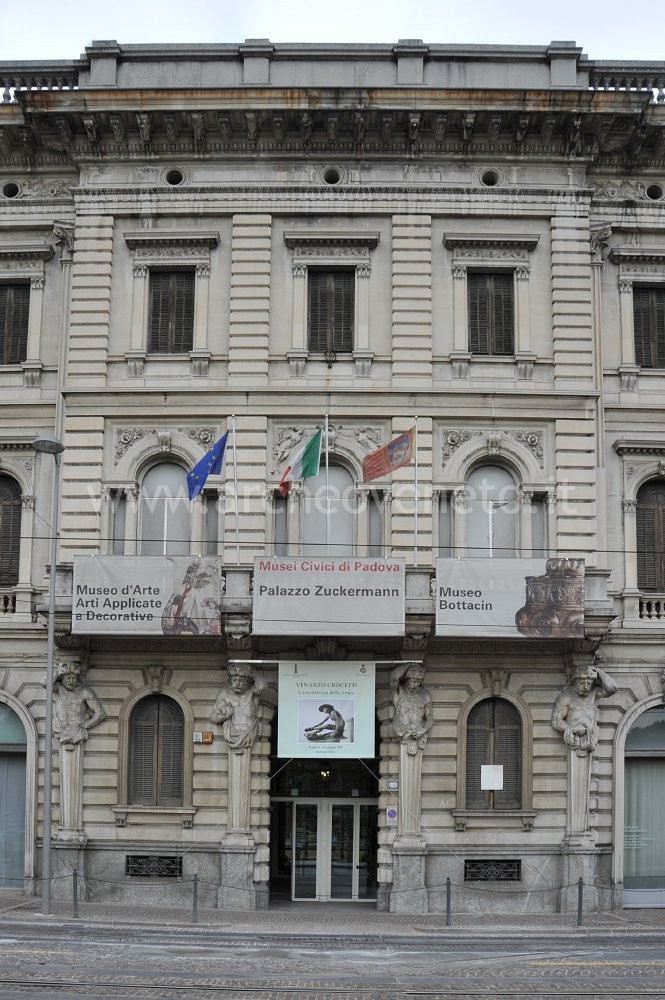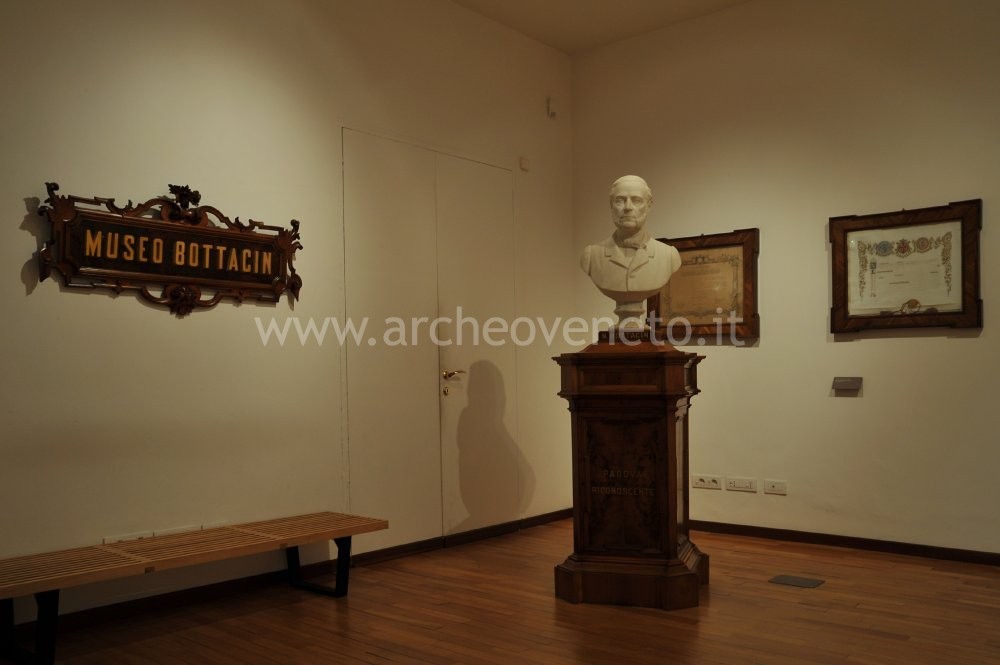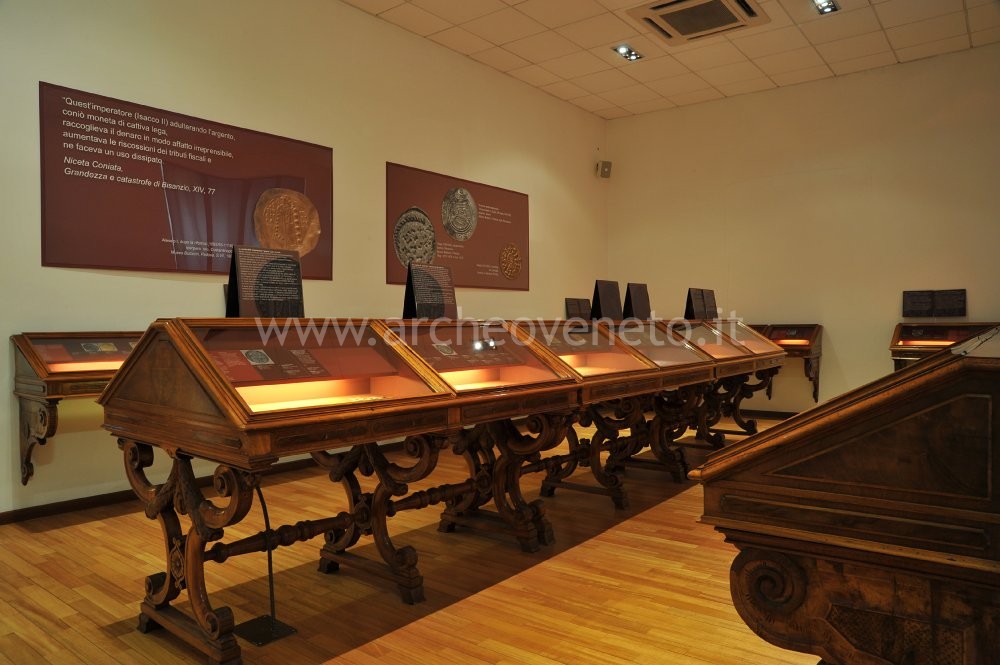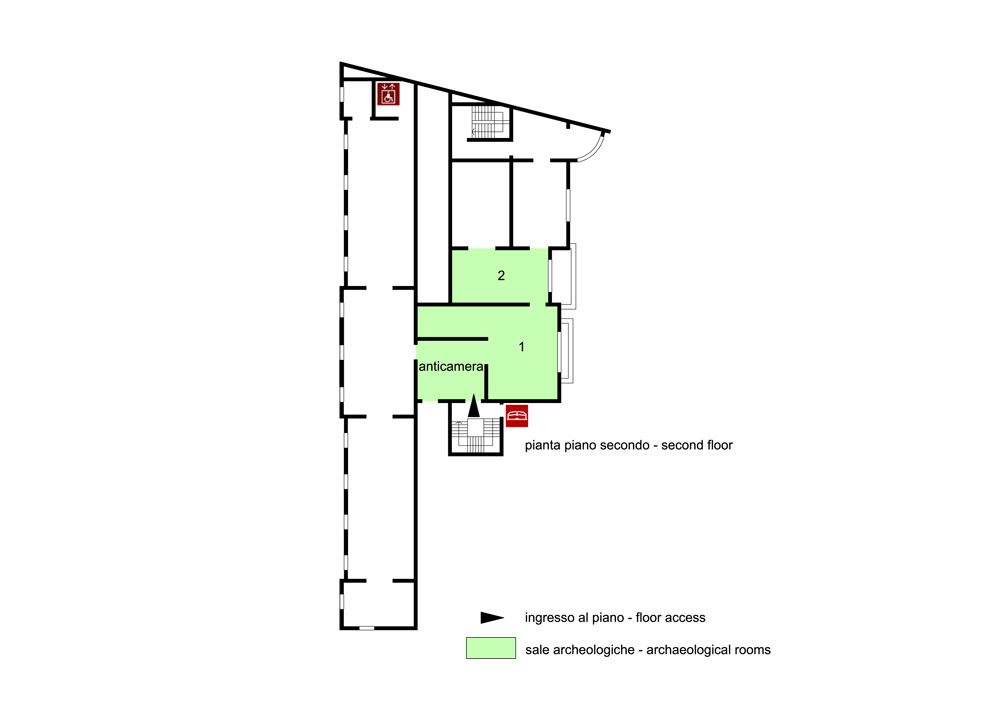|
|
File
“Nicola Bottacin” Numismatic Museum – Padova
|
| Corso Garibaldi 33 – 35100 Padova (PD)
|
  |
|
Summary

The Bottacin Museum is located on the second floor of the Zuckermann Palace, which was generously donated to the municipality by Nicola Bottacin, a trader from Trieste. He was eager to have a museum that bore his name; therefore between 1865 and 1870 he donated to the municipality of Padua his rich collection of works of art (paintings, furniture, sculptures and manuscripts) and of ancient and modern coins (more than 100,000). Approximately two thirds of the items displayed stem from following bequests and purchases, which made this museum an essential point of reference for the experts of numismatics all over Europe.
|

 The room serving as entrance hall of the museum has the task of providing information on the magnate Nicola Bottacin. Beside the description of the life of the wealthy trader, it is possible to see a portrait dating back to 1896 and a bust, both accomplished by Cameroni. The rest of the exhibition is organised along two paths, one regarding the works of art and the other one devoted to numismatics. The room serving as entrance hall of the museum has the task of providing information on the magnate Nicola Bottacin. Beside the description of the life of the wealthy trader, it is possible to see a portrait dating back to 1896 and a bust, both accomplished by Cameroni. The rest of the exhibition is organised along two paths, one regarding the works of art and the other one devoted to numismatics.
|

 The first room regards the Greek and Roman coins. The exhibition starts from the origin of coins, which took place in Lydia in 580 B.C. and goes on until the fall of the Roman Empire, with the purpose of presenting the different stages of the ancient history in which this fundamental tool was considered a socio-political, economic and commercial and even artistic experience. The first room regards the Greek and Roman coins. The exhibition starts from the origin of coins, which took place in Lydia in 580 B.C. and goes on until the fall of the Roman Empire, with the purpose of presenting the different stages of the ancient history in which this fundamental tool was considered a socio-political, economic and commercial and even artistic experience.
The visit starts from the right with the first nineteenth-century display rack, which contains the Greek coins. The most ancient ones are mainly silver obols and tetradrachms representing the owl, the iconographic symbol of Athens, which can be traced back to a time span between the late 6th century B.C. and the 3rd century B.C. In this section it is also possible to see the coins coming from Sicily and the cities of Magna Graecia. It is easy to notice that each polis had a different coin, which often reproduced the symbol of the city or animals or products of the land that were sacred to the local deity.
The Greek coins include also those of Alexander the Great, which in the 4th century had the important function of harmonising the coins used in the ancient Greece (gold staters and silver tetradrachms), thus becoming the model for all the coinages of the following Hellenistic kingdoms.
At the centre of the room, the display case in front of the Greek coins contains the Celtic ones coming from different regions of northern Italy (Lombardy, Liguria-Piedmont and Veneto). These coins are important to understand the historical events that took place between the 4th and the 1st century B.C.: the Celts had fought as mercenaries for the great Macedonian kings (Philip II, Alexander the Great), so when they went back to their homeland, they imported and reproduced the kind of coins they had seen. To this regard, it is important to report the discovery of a box room, in Padua, in via Ospedale, which is very likely to have stored a remarkable amount of Venetic drachms.
Always at the centre of the room, but on the left side there is a display case containing the first coins produced in Rome at the end of the 4th century B.C. They include some bronze and silver coins reproducing those used in Magna Graecia and large bronze cast coins (in Latin “aes grave”) traditionally used in central Italy. In 214 B.C. a new monetary system was introduced, which was based on the silver denarius; this coin became the most important one in the Roman world, at least until the end of the 3rd century A.D. To this regard, a small treasure of 659 republican denarii was found in via Gabelli in Padua, which can be traced back to the age of civil wars (89-45 B.C.).
An important moment in the history of Ancient coins was marked by the monetary reform introduced by Augustus, which enabled the Roman economy to recover from the serious crisis caused by the civil wars, which had lasted approximately one century, and to finally thrive again. One of the most important consequences was the monetary harmonization of almost all the Roman Empire; the museum contains a set of Augustan coins coming from different regions of the world (Pergamon, Ephesus, Lugdunum, etc.) and which display similar characteristics, thus bearing evidence to this important event. These coins belong to the Imperial series, which has on the obverse the idealized portrait of the emperor and on the reverse monuments or other images that can clearly be classified as propaganda of the Empire. Over time this kind of coin underwent numerous evolutions, as the Bottacin Museum clearly shows. For instance, the Emperor Nero introduced thr physiognomical portraits, which reproduced the real features of the emperor, whereas the Flavian dynasty restored the style of the Augustan age. The display case containing coins referring to this period contains some aurei, silver and bronze sesterces representing the Colosseum and displaying the writing “IUDEA CAPTA”, which have to be seen as a form of propaganda.
The second part of the room, which is slightly shifted to the left, contains some material dating back to the last phase of the roman-imperial monetary system. This period was characterized by a break-up of the monetary organization introduced by Augustus, as a consequence of the deep political and military crisis that the Roman Empire had to face in the 2nd cent. A.D. The emperors that reigned in this phase attempted to overcome the stalemate minting new coins (antonianii, aurelianii, folles and solidii), all of which were introduced between the 3rd and 4th cent. A.D.
Inside the museum there are different examples of these coins, which are placed in chronological order according to the time in which they were issued. Further evidence to this declining phase is provided by the numerous accumulations of capital that took place in the 3rd and 4th centuries A.D. An example is provided by a set of bronze coins donated to the museum, which can be traced back to the a time between 348 and 354 A.D. coming from a box room, the exact location of which is unfortunately unknown (probably they come from the Balkan peninsula).
The following display case contains Byzantine coins, which were based on the roman tradition of using three metals, even though numerous reforms were then introduced: in particular one of the most important was the one accomplished by Anastasius approximately in 498 A.D.
|

 This room contains the monetary finds dating back to the Middle-Ages and the modern age, with a particular focus on the mints of the Veneto region. All the coins displayed, like the Greek and Roman ones, are accompanied by an introductory panel providing general information on the events happened throughout the centuries and by a set of detailed captions. This room contains the monetary finds dating back to the Middle-Ages and the modern age, with a particular focus on the mints of the Veneto region. All the coins displayed, like the Greek and Roman ones, are accompanied by an introductory panel providing general information on the events happened throughout the centuries and by a set of detailed captions.
|

Admission: Negli orari di apertura
Ticket: Si
Price: Full fare (Zuckermann Palace, Civic Museums, Scrovegni Chapel): 12 €; full fare (Zuckermann Palace and Civic Museums): 10 €; reduced fare: 8 €; reduced special fare: 5 €. Free admission: children below 6 years of age and people with disabilities. Discounts are granted to holders of the Padovacard, Padova Musei tutto l’anno and Padova Musei Famiglia cards.
 School access School access
 Disabled access Disabled access
Opening Days
| Tipology |
When |
Specs |
| Summer/Winter |
Tuesday |
10.00 – 19.00 |
| Summer/Winter |
Wednesday |
10.00 – 19.00 |
| Summer/Winter |
Thursday |
10.00 – 19.00 |
| Summer/Winter |
Friday |
10.00 – 19.00 |
| Summer/Winter |
Saturday |
10.00 – 19.00 |
| Summer/Winter |
Sunday |
10.00 – 19.00 |
Recommended tour time (minutes): 60
 Toilet Toilet
 Bookshop Bookshop
It has been planned, but not accomplished yet. There is a case containing all the publications regarding the museum.
 Rest points Rest points
 Guide a stampa Guide a stampa
Brochure
Catalogo
 Information boards Information boards
Italian and English
 Captions under exhibits Captions under exhibits
Italian
 Multilingual ads: Inglese Multilingual ads: Inglese
Explanatory panels
 Guided Tours Guided Tours
 Educational activities Educational activities
 Educational workshops Educational workshops
 Library and documentation centre Library and documentation centre
There is a very large telematic library (30,000 books), open on Mondays, Wednesdays and Fridays from 9.00 to 13.30 and on Tuesdays and Thursdays from 9.00 to 13.30 and from 15.00 to 17.30. There is also a rich Cabinet of Prints and Drawings.
| Gorini G. 1972, Monete antiche a Padova, Padova. |
| Gorini G. 1973, Monete romane repubblicane del Museo Bottacin di Padova, Venezia. |
| Saccocci A. 1992, Museo Bottacin. Cenni storici, in Musei Civici agli Eremitani. Padova, a cura di Banzato D., Milano, pp. 81-95. |
| Alle radici dell’euro. Quando la moneta fa la storia 2001, Treviso. |
| Musei Civici di Padova. Museo Bottacin. Guida 2004, a cura di Callegher B., Milano, pp. 41-69. |
| Bonetto J. 2009, Veneto (Archeologia delle Regioni d’Italia), Roma, pp. 396-397. |
|

